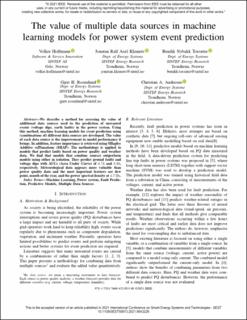| dc.contributor.author | Hoffmann, Volker | |
| dc.contributor.author | Klemets, Jonatan Ralf Axel | |
| dc.contributor.author | Torsæter, Bendik Nybakk | |
| dc.contributor.author | Rosenlund, Gjert Hovland | |
| dc.contributor.author | Andresen, Christian Andre | |
| dc.date.accessioned | 2022-03-11T12:34:42Z | |
| dc.date.available | 2022-03-11T12:34:42Z | |
| dc.date.created | 2021-08-11T09:22:38Z | |
| dc.date.issued | 2021 | |
| dc.identifier.citation | 2021 International Conference on Smart Energy Systems and Technologies - SEST | en_US |
| dc.identifier.isbn | 978-1-7281-7660-4 | |
| dc.identifier.uri | https://hdl.handle.net/11250/2984658 | |
| dc.description.abstract | We describe a method for assessing the value of additional data sources used in the prediction of unwanted events (voltage dips, earth faults) in the power system. Using this method, machine learning models for event prediction using (combinations of) different data sources are developed. The value of each data source is the improvement in model performance it brings. In addition, feature importance is retrieved using SHapley Additive exPlanations (SHAP). The methodology is applied to models that predict faults based on power quality and weather data. We find that models that combine sources outperform models using either in isolation. They predict ground faults and voltage dips with AUCs (Area Under Curve) of 0.74 and 0.80, respectively. Meteorological data appears more valuable than power quality data and the most important features are dew point, month of the year, and the power spectral density at 4.7 Hz | en_US |
| dc.language.iso | eng | en_US |
| dc.publisher | IEEE | en_US |
| dc.relation.ispartof | 2021 International Conference on Smart Energy Systems and Technologies - SEST | |
| dc.title | The value of multiple data sources in machine learning models for power system event prediction | en_US |
| dc.type | Chapter | en_US |
| dc.type | Peer reviewed | en_US |
| dc.description.version | acceptedVersion | en_US |
| dc.identifier.cristin | 1925244 | |
| dc.relation.project | Norges forskningsråd: 268193 | en_US |
| cristin.ispublished | true | |
| cristin.fulltext | postprint | |
| cristin.qualitycode | 1 | |
